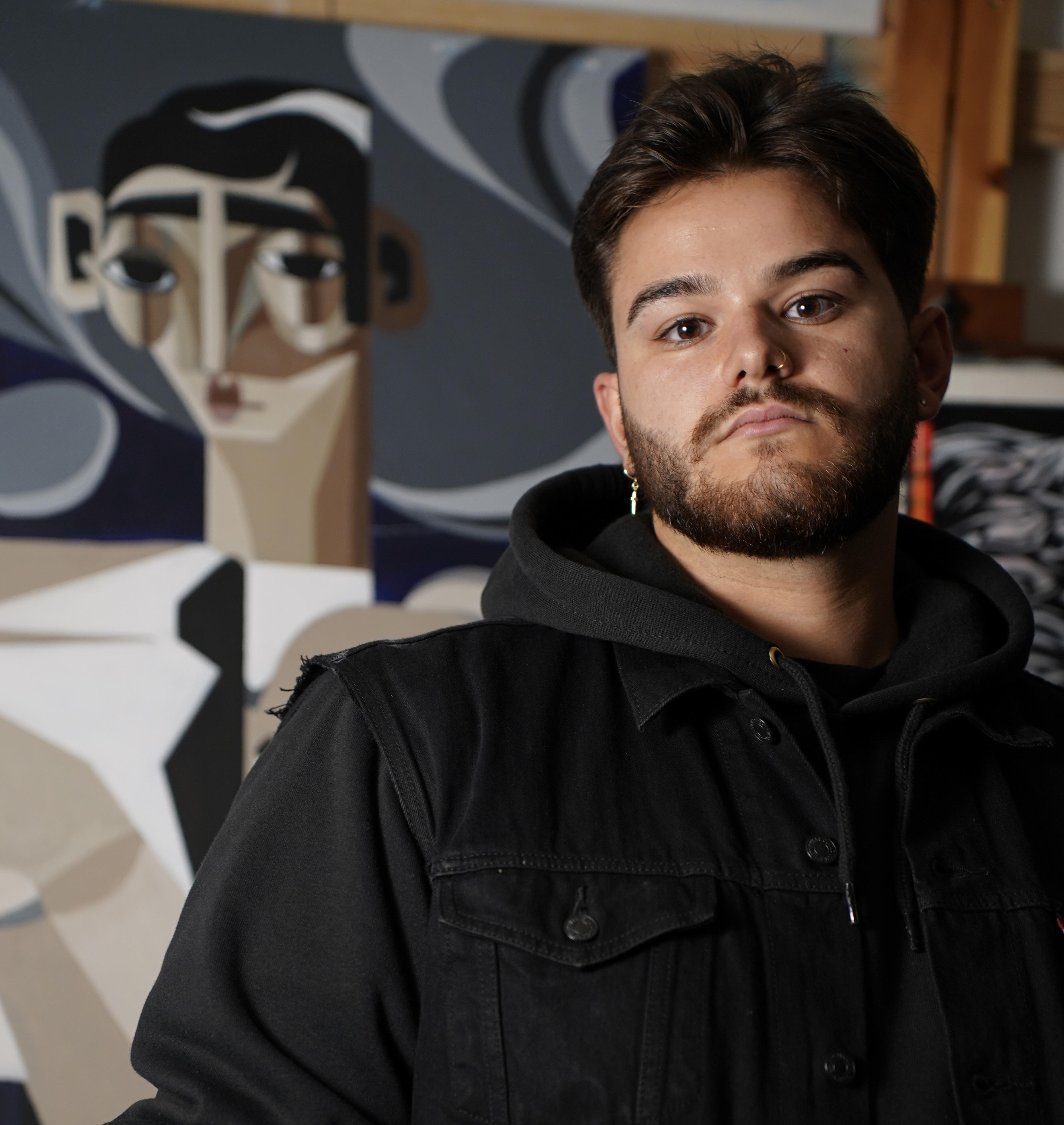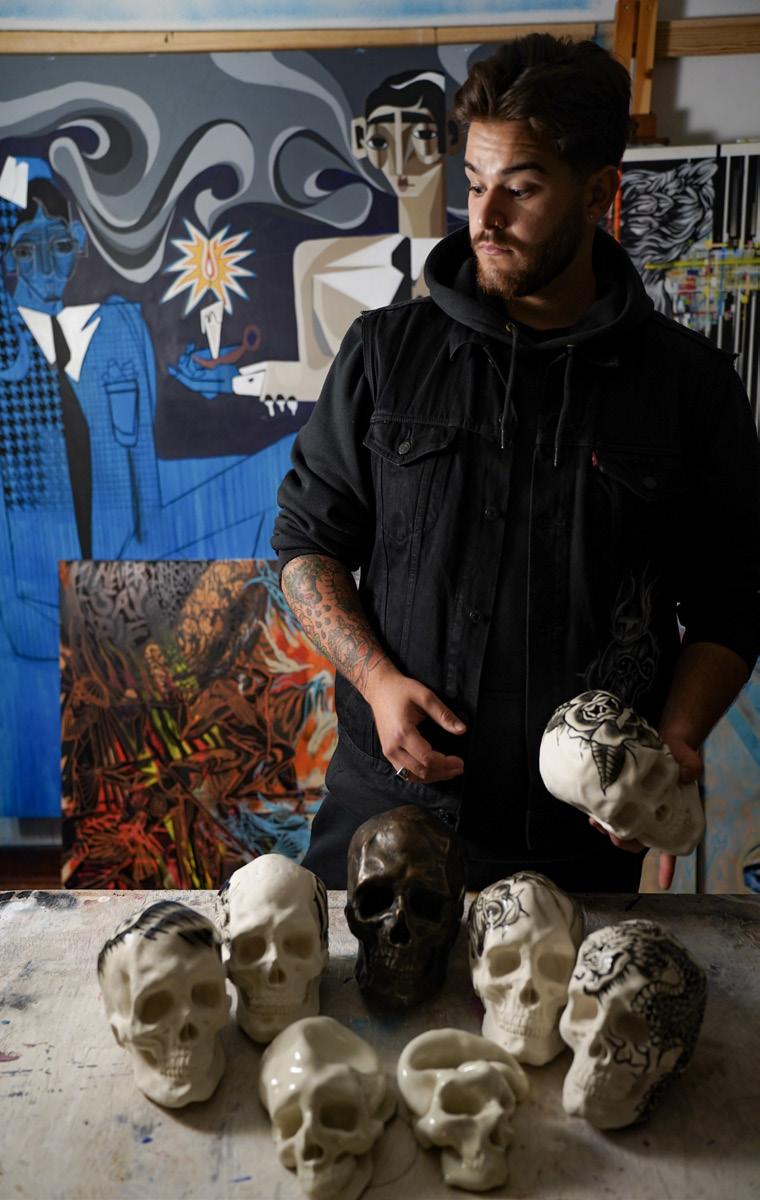
5 minute read
Inside the Mind of Andrew Abballe
Andrew Abballe’s only concern as an artist is whether or not he’s consistently evolving. He isn’t here for labels or the subjective nature of art, he’s here for the expression.
Written by: Andrea Rella Photography by: Christian Coccuzzo
Advertisement
A
ndrew Abballe is in his element-Shorts, a sweater, and surrounded by his masterpieces in his cozy yet busy home studio. His hospitality doesn’t go unnoticed as he brings a few waters and espressos accompanied by some sambuca to add to the stimulant (the Italian sugar *wink wink*). Every nook and cranny of his basement studio is taken up by his art that’s either finished or partly finished; some are a workin-progress, some he’ll never get back to, and the ones that are finished are stowed away because he doesn’t really think of them. “You know it’s funny, there’ll be times when I finish a piece and I’ll love it, but then a month later I’ll hate that same piece because I’ll start to see all the flaws. Maybe I overthink too much because there’s this constant need of proving myself as an artist.” For any type of artist, releasing art is always tough because of the vulnerability attached so something near their definition of perfect is the goal. It’s deflating when your art isn’t coming out the way you envisioned it, but the key is doing your personal best so that you could let go. Andrew recalls speaking to an artist that’s an inspiration, “I overthink many of my paintings so I DM’d an artist who wraps his canvas’ first then paints overtop of them and still finishes quickly. I asked him how to paint that fast and he simply said just paint faster. The thing is no one really cares, so don’t lose the forest for the trees. That prompted him to explore different forms of artistry like custom shoes, jackets and sculpting which allows him to exercise his various interests. With every new work brings forth some old techniques, while practicing new ones that create a medley and effectively knock him out of his own comfort zone. It’s when an artist gets comfortable that it becomes demoralizing and he’d rather stay away from that because, ““Once you become a
blue-chip gallery selling artist and become famous for one style, you’ll continually be asked to make the same paintings for the rest of your career and that could be deflating.” Getting his BFA (Bachelor of Fine Arts) from York University was the turning point for him. “It was external validation, and concrete evidence that I was an artist. Because academics is important to my evolution, I want to get my MFA and become a professor one day.” Consistently evolving through academics is how he envisions his growth, but he also understands and appreciates artists who’re not classically trained as they bring something exciting to the table. “They don’t work in a vacuum” so they’re not bound by the confines of what they were taught but instead they’re allowing the creative energy to envelop them and take them somewhere limitless.

Andrew accompanied by the skulls he hand sculpted
The different types of art that consumes Andrew allows for a more free-flowing work process. Treating every piece like their own entity, he gives them the respect and space to be what they’re supposed to be even if mistakes happen. It’s all a part of his creative process which is even more amazing once you find out that he’s color blind. “Primary colors are easier to see but once I get into secondary and tertiary that’s when they kind of blend together.” His younger self tried to ignore the fact but as he got older, he realized he could use it to his advantage. “Most times I’m just feeling my way through the piece.” His creative instinct has only grown stronger as he’s allowing his visual impairment to guide him. He’s currently in the process of working on a commissioned sculpture for a church which is coming out great because he has creative freedom
Someone will come up to him with an idea, he’ll work on it with full creative freedom, get their opinion on the piece and go from there. It’s when he doesn’t have creative freedom that he’s forced to look at it from a different angle, “There are pieces where someone will come to me with a vision already and I have to execute their vision with little creative freedom, so I use that as practice because I’m not emotionally tied to the project.” It’s a balancing act juggling your needs and wants as an artist, but somethings got to give; even Michelangelo took jobs that he wasn’t emotionally tied to.
It’s all relative since people are a product of their times. Artists were always known for reflecting society at the time but artists that made some of the most transformative artwork to date, still wouldn’t appeal in today’s world because their mindset is different than today’s. “It’s a different world but it’s a cycle and everything comes full circle. Charles Boudelaire said it best when he called artists “a flaneure which is someone who watches and reflects what’s going on but isn’t a part of it, so I think artists are mirrors of society”. There needs to be art in society just as there needs to be text in books but with the world moving digital, art is different than what we’ve come to know. NFTs, digital art, art posted straight to social media where anyone has an opinion is the kind of art that’s popular nowadays which doesn’t faze Andrew. Referencing Damien Hurst when it comes to people critiquing an artist’s work, he says, “If your art doesn’t piss off at least 3 people in a room of 10, you’re doing something wrong.” That outlook allows the young artists the space to be okay with not appealing to everyone and instead, seeing the value in that. Art doesn’t always make sense to everyone, but if it gets you thinking then it’s doing its job. Whichever way the world is heading, Andrew Abballe understands, “I’m constantly growing and learning so that my artistry can evolve and grow with me. I’m a lifelong learner so I don’t know if I can call myself an artist just yet, I still have so much more to learn”




